|
|
 |
Fiche d'espèce de Copépode |
|
|
Calanoida ( Ordre ) |
|
|
|
Arietelloidea ( Superfamille ) |
|
|
|
Augaptilidae ( Famille ) |
|
|
|
Haloptilus ( Genre ) |
|
|
| |
Haloptilus ocellatus Wolfenden, 1905 (F,M) | |
| | | | | | | Ref.: | | | Wolfenden, 1905 a (p.14, Descr.F, fig.F); 1911 (p.324, Rem.); Brady, 1918 (p.28, figs.F: defective); Farran, 1929 (p.209, 268); Sewell, 1948 (p.575); Vervoort, 1951 (p.143, Rem.); 1957 (p.138, Rem.); Tanaka, 1960 (p.54, figs.F); Bradford, 1971 b (p.26, Descr.M, figs.F,M, Rem.); Matthews, 1972 (p.51); Park, 1988 (p.4, Redescr.F, figs.F, Rem.); Bradford-Grieve & al., 1999 (p.883, 941, figs.F,M); Cheng F. & al., 2013 (p.119, molecular biology, GenBank) | 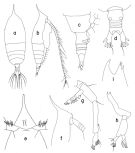 issued from : T. Park in Antarct. Res. Ser. Washington, 1988, 47. [p.8, Fig.3]. Female: a, habitus (dorsal); b, idem (lateral right side); c, last thoracic segment and urosome (lateral right side); d, urosome (dorsal); e, forehead (ventral); f, idem (lateral); g, A2; h, Md; i, Md (biting edge). Nota: Prosome about 6 times length of urosome. Rostrum with 2 rather small filaments. Spermatheca large and in lateral view somewhat elongate in a dorsal direction. Caudal rami nearly as long as combined lengths of 3 preceding urosomal segments.
|
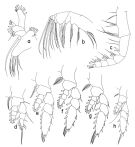 issued from : T. Park in Antarct. Res. Ser. Washington, 1988, 47. [p.9, Fig.4]. Female: a, Mx1; b, Mx2; c, Mxp; d, P1 (anterior); e, P2 (anterior); f, P3 (anterior); g, P4 (anterior); h, P5 (anterior). Mx2: 1st to 6th protopodal lobes with 3+2+2+2+2+3 setae; one of the setae on 5th and 6th lobes more or less sickle-shaped; endopod with 7 setae.
|
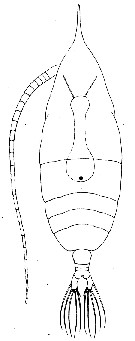 issued from : R.N. Wolfenden in Plankton Studies Part I. Copepoda. 1905 [Pl.V]. Female : habitus (dorsal).
|
 issued from : J.M. Bradford-Grieve, E.L. Markhaseva & C.E.F. Rocha & B. Abiahy in South Atlantic Zooplankton, Edit. D. Boltovskoy. 1999. Vol.2. Copepoda. [p.1043, Fig. 7.275]. Female: Mx1.
|
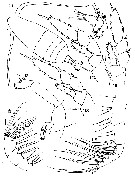 Issued from : J.M. Bradford in N.Z. Oceanogr. Inst., 1971, 206, Part 8, No 59. [p.26, Fig.111-118]. Male (from Ross Sea): 111, habitus (dorsal); 112, A2; 113, Mx1; 114, Mx2; 115, Mxp; 116, P2; 117, P3; 118, P4. Scale bar: 1 mm (Fig.11); 100 µm (on the rest). Nota: Cephalosome and 1st thoracic segment separate, 4th and 5th thoracic segments fused. A2 with small 7-segmented exopod attached near base basis (this limb not quite as slender as in H. oxycephalus). Mx2 and Mxp like those of H. oxycephalus. P1-4 like those of H. oxycephalus. ''Glandular pores'' (also present in H. oxycephalus) occur on swimming legs. Extra pore on a 2nd exopodal segment of P3 and a 3rd exopodal segment of P4. Terminal exopodal spine in H. ocellatus proportionally shorter with respect to 3rd exopodal segment segment than in H. oxycephalus. All exopod external spines bordered with minute teeth. P5 similar to that of H. oxycephalus with small differences.
|
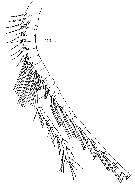 Issued from : J.M. Bradford in N.Z. Oceanogr. Inst., 1971, 206, Part 8, No 59. [p.27, Fig.119]. Male (from Ross Sea): 119, right A1. Scale bar: 100 µm. Nota: Right A1 25-segmented, reaches anal segment
|
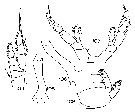 Issued from : J.M. Bradford in N.Z. Oceanogr. Inst., 1971, 206, Part 8, No 59. [p.25, Figs.104-108]. Male (from Ross Sea): 104, P1; 105, left Md (gnathobase); 106, right Md (gnathobase); 107, P5; 108, Md (palp) Scale bar: 100 µm. Nota: Md with strong anterior tooth and 2-3 weaker posterior teeth. Left Md of H. oxycephalus differs in having a shorter anterior tooth. Palp with 2 setae on endopod segment 1, 7 setae and patch of hairs on 2nd endopodal segment. Mx1 very like that of H. oxycephalus and not as in Vervoort (1957). Only observable difference was in number of setae on terminal part of endopod: H. oxycephalus has 3 large and 2 small setae, whereas H. ocellatus bears 3 small and 1 large setae
|
 Issued from : J.M. Bradford in N.Z. Oceanogr. Inst., 1971, 206, Part 8, No 59. [p.25, Figs.109-110]. Female (from Ross Sea): 109, left Md (edge of gnathobase); 110, right Md (edge of gnathobase). Scale bar: 100 µm.
|
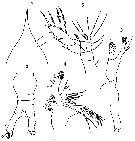 Issued from : O. Tanaka in Spec. Publs. Seto mar. biol. Lab., 10, 1960 [Pl. XXIV, 1-5]. Female (from 67°03'S, 40°44'E): 1, forehead (dorsal); 2, abdomen (dorsal); 3, Md (palp and gnathobase); 4, Mx1; 5, P5. Same scale in figs. 3, 4 and 5. Nota: The characteristic black eye spot on the back was not observed in the specimen. The body was soft-skined and hyaline.
| | | | | Ref. compl.: | | | Hardy & Gunther, 1935 (1936) (p.182, Rem.: rare); Baker, 1954 (p.203, 211, fig.5); Murano, 1965 (p.91, Rem.: p.123); Hopkins, 1985 (p.197, Table 1, gut contents); Zmijewska, 1987 (tab.2a); Hopkins & Torres, 1988 (tab.1); Rau & al., 1991 (p.1, isotopic forms vs feeding); Hosie & Cochran, 1994 (tab.2, fig.2); Fransz & Gonzalez, 1997 (p.395, weight-length, biomass v.s. N-S transect, as ocellata); Voronina & Kolosova, 1999 (p.71); Razouls & al., 2000 (p.343, tab. 3, 5, Appendix); Li & al., 2001 (p.894, tab.1); Schnack-Schiel & al., 2008 (p.1045: Tab.2); Park & Ferrari, 2009 (p.143, Table 3, 7: common deepwater species, fig.1, Appendix 1, biogeography); Yang & al., 2011 a (p.921, Table 2, inter-annual variation 1999-2006); Michels & al., 2012 (p.369, Table 1, occurrence frequency); Kouwenberg & al., 2014 (p.290, biogeography, Map 5) | | | | NZ: | 3 | | |
|
Carte de distribution de Haloptilus ocellatus par zones géographiques
|
| | | | | |  issued from A. de C. Baker in 'Discovery' Rep., 1954, 27. [p.215, Fig.5]. issued from A. de C. Baker in 'Discovery' Rep., 1954, 27. [p.215, Fig.5].
Occurrence of Haloptilus ocellatus in all longitudes around Antarctic zone of the Southern Ocean.
The percentage frequency of occurrence in samples taken within every 20° of longitude.
Nota: During the 'Discovery' investigations some thousands of plankton samples have been taken from stations spread over the whole of the Southern Ocean at all seasons of the year, the majority south of the Antarctic Convergence. An arbitrary selection of samples has been made from hauls between the surface and a depth of 250 m, which means that they have been taken from within the limits of the Antarctic surface water. |
 Issued from : E.T. Park & F.D. Ferrari in A selection from Smithsonian at the Poles Contributions to International Polar year. I. Krupnik, M.A. Lang and S.E. Miller, eds., Publs. by Smithsonian Institution Scholarly Press, Washington DC., 2009. [p.165, Fig.1] Issued from : E.T. Park & F.D. Ferrari in A selection from Smithsonian at the Poles Contributions to International Polar year. I. Krupnik, M.A. Lang and S.E. Miller, eds., Publs. by Smithsonian Institution Scholarly Press, Washington DC., 2009. [p.165, Fig.1]
Distribution of selected pelagic calanoids Haloptilus ocellatus of the Southern Ocean and the closest relative. |
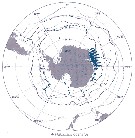 Issued from : J.H.M. Kouwenberg, C. Razouls & N. Desreumaux in Biogeographic Atlas of the Southern Ocean, Scient. Comm. Antarct. Res., Cambridge, 2014, 6.6. [p.291, Map 5]. Issued from : J.H.M. Kouwenberg, C. Razouls & N. Desreumaux in Biogeographic Atlas of the Southern Ocean, Scient. Comm. Antarct. Res., Cambridge, 2014, 6.6. [p.291, Map 5].
Distribution of Haloptilus ocellatus. |
| | | | Loc: | | | Antarct. (Croker Passage, Peninsula, Weddell Sea, SW Atlant., Indian, SW & SE Pacif., Ross Sea, Prydz Bay), South Georgia, sub-Antarct. (SW & SE Pacif.), Atlant. (SW & SE) | | | | N: | 37 | | | | Lg.: | | | (25) F: 8,55-7,2; (35) F: 8,5-8,2; (66) F: ± 7,9; (102): F: 8,3; M: 4,1; (312) F: 8,55-7,95; {F: 7,20-8,55; M: 4,10} | | | | Rem.: | épi-mésopélagique.
Sampling depth (Antarct., sub-Antarct.): 50-1000 m.
Voir aussi les remarques en anglais | | | Dernière mise à jour : 13/11/2015 | |
|
|
 Toute utilisation de ce site pour une publication sera mentionnée avec la référence suivante : Toute utilisation de ce site pour une publication sera mentionnée avec la référence suivante :
Razouls C., Desreumaux N., Kouwenberg J. et de Bovée F., 2005-2025. - Biodiversité des Copépodes planctoniques marins (morphologie, répartition géographique et données biologiques). Sorbonne Université, CNRS. Disponible sur http://copepodes.obs-banyuls.fr [Accédé le 28 décembre 2025] © copyright 2005-2025 Sorbonne Université, CNRS
|
|
 |
 |













